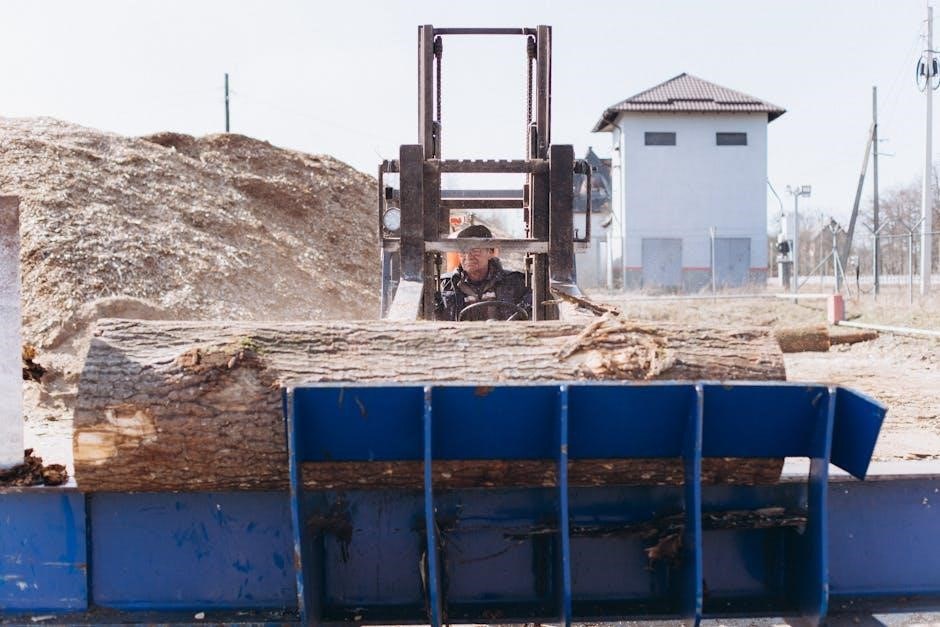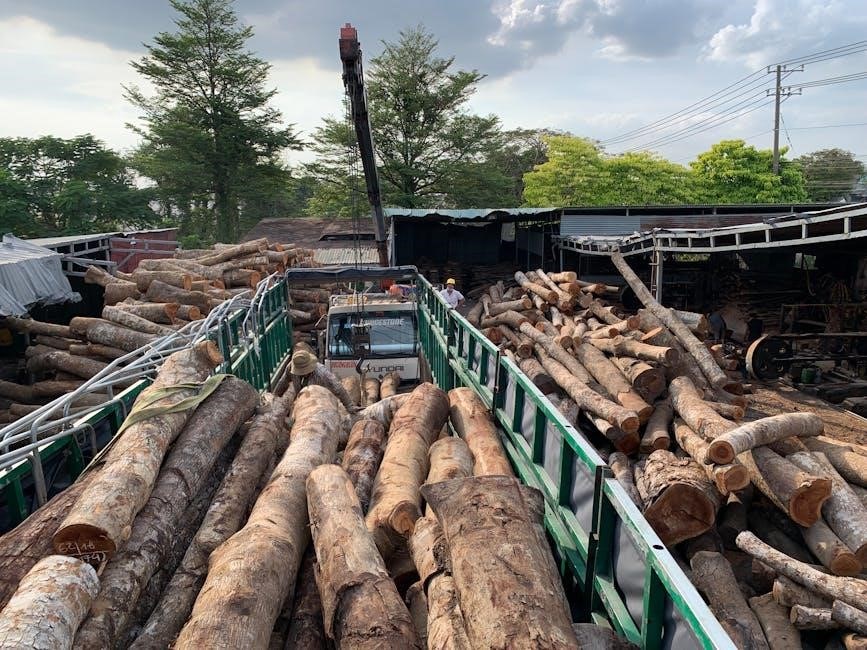Manual sawmill is a machine used for cutting logs into lumber using a manual process with various tools and equipment available online.
Definition and Purpose
A manual sawmill is a device designed to cut logs into lumber, allowing for the production of wooden planks and boards. The purpose of a manual sawmill is to provide a means of processing logs into usable lumber, enabling the creation of various wooden products. This type of sawmill is often used in small-scale woodworking operations or by individuals who require a manual means of cutting logs. The definition of a manual sawmill encompasses a range of devices, from simple, handheld tools to more complex, freestanding machines. The primary purpose of a manual sawmill is to enable the efficient and effective cutting of logs, allowing for the production of high-quality lumber. By using a manual sawmill, individuals can produce their own lumber, reducing reliance on external suppliers and enabling greater control over the production process.
Benefits of Manual Sawmill
The benefits of a manual sawmill include cost-effectiveness, flexibility, and environmental sustainability. Manual sawmills are often less expensive to purchase and maintain than automated sawmills, making them a viable option for small-scale woodworking operations. They also offer flexibility in terms of the types of logs that can be cut and the sizes of lumber that can be produced. Additionally, manual sawmills are a more environmentally friendly option, as they do not require the use of electricity or fossil fuels, reducing carbon emissions and minimizing waste. Overall, the benefits of a manual sawmill make it an attractive option for those looking to produce high-quality lumber while minimizing costs and environmental impact, and they can be used in a variety of settings, from small workshops to rural communities. This makes them a popular choice for many woodworkers.

Design and Construction
Manual sawmill design involves creating a functional and efficient system using various materials and components online resources.
Plan and Drawings
Manual sawmill plans and drawings are essential for building a functional and efficient system. These plans provide a detailed understanding of each part and its construction, including hole placements, component positions, and size. The plans can be used to guide the building process, whether starting from scratch or assembling a kit. They include parts lists and suppliers for each component, cut lists for breaking down full lengths of steel, and step-by-step assembly instructions. The plans are available online and can be used in combination with assembly videos to ensure a smooth and successful build. With these plans, users can build a wide slabber bandsaw mill capable of handling and cutting large logs. The plans are comprehensive and include all the necessary details to build a manual sawmill.
Materials and Components
The manual sawmill requires various materials and components to function effectively. These include steel, such as flat steel and box steel, for the frame and other structural elements. Additional components like wheels, axles, and bearings are also necessary for the sawmill’s operation. The type and quality of materials used can impact the sawmill’s performance and durability. A list of required materials and components is typically provided with the sawmill plans, making it easier to source and prepare the necessary items. The materials and components must be carefully selected and assembled to ensure the sawmill operates smoothly and efficiently. Proper selection and assembly of these components are crucial for the sawmill’s overall performance and longevity, and for achieving the desired cutting results. The right materials can make a significant difference in the sawmill’s functionality.

Building a Manual Sawmill
Manual sawmill construction requires careful planning and execution using online plans and guides available.
Step-by-Step Instructions
To build a manual sawmill, start by gathering materials and tools, then follow a series of steps outlined in online guides and plans.
The process involves cutting and assembling various components, including the frame, wheels, and blade.
Each step should be carefully executed to ensure the sawmill is safe and functional.
The instructions typically include diagrams and illustrations to help with the assembly process.
It is essential to follow the instructions carefully to avoid mistakes and ensure the sawmill is built correctly.
The step-by-step instructions provide a clear and detailed guide on how to build a manual sawmill, making it possible for individuals to construct their own sawmill at home.
The instructions are usually available online, and they can be downloaded or printed for easy reference.
The manual sawmill can be built using basic tools and materials.
Tools and Equipment
The manual sawmill requires various tools and equipment to operate efficiently, including a saw blade, wheels, and a frame.
A list of necessary tools and equipment can be found online, along with guides on how to use them.
The tools and equipment needed may vary depending on the type of sawmill being built.
Some common tools used include wrenches, saws, and drills.
The equipment needed may include a motor, gearbox, and bearings.
The tools and equipment should be of high quality to ensure the sawmill operates smoothly and safely.
Proper use and maintenance of the tools and equipment are essential to extend their lifespan.
The right tools and equipment can make a significant difference in the performance and productivity of the manual sawmill, allowing for efficient cutting and processing of logs.

Types of Manual Sawmills
Manual sawmills include wide slabber and portable types available online.
Wide Slabber Bandsaw Mill
A wide slabber bandsaw mill is a type of manual sawmill that can handle and cut large diameter logs into lumber. The mill uses a bandsaw blade to make the cuts, and is typically powered by a manual or mechanical system. This type of mill is ideal for cutting large slabs of wood, and can be used to produce a variety of lumber products. The wide slabber bandsaw mill is a popular choice among woodworkers and sawmill operators due to its ability to produce high-quality lumber with minimal waste. The mill’s design and construction allow for smooth and stable cuts, making it a valuable tool for any woodworking or sawmilling operation. With proper maintenance and operation, a wide slabber bandsaw mill can provide years of reliable service.
Portable Sawmill

A portable sawmill is a type of manual sawmill that can be easily transported and set up on site. This type of mill is ideal for small-scale sawmilling operations or for those who need to mill lumber in remote locations. Portable sawmills are often designed to be compact and lightweight, making them easy to move and store. They can be powered by a variety of means, including manual, mechanical, or engine-driven systems. With a portable sawmill, users can produce high-quality lumber on site, reducing the need for transportation and increasing efficiency. The portability of these mills also makes them a great option for those with limited space or who need to mill lumber in different locations. Overall, portable sawmills offer a convenient and flexible solution for sawmilling needs. They are also relatively affordable and easy to maintain;
Manual sawmill provides a reliable solution for lumber production with various tools and equipment available online easily.
A manual sawmill is a valuable tool for producing lumber, offering a cost-effective and efficient solution for wood processing needs. The use of a manual sawmill allows for the production of high-quality lumber with minimal waste. With the right tools and equipment, a manual sawmill can be a reliable and productive addition to any woodworking operation. The process of using a manual sawmill involves careful planning and execution, but the end result is well worth the effort. By utilizing a manual sawmill, individuals can create a wide range of wood products, from lumber and plywood to furniture and other wood items. Overall, a manual sawmill is a useful tool for anyone looking to produce high-quality lumber and wood products. The benefits of using a manual sawmill are numerous and well-documented.
Future Prospects
The future of manual sawmills looks promising, with advancements in technology and design expected to improve efficiency and productivity. As the demand for sustainable and eco-friendly wood products continues to grow, manual sawmills are likely to play a key role in meeting this demand. With the development of new materials and techniques, manual sawmills may become even more versatile and capable of producing a wider range of wood products. Additionally, the rise of DIY and small-scale woodworking operations is expected to drive the demand for manual sawmills, making them an essential tool for many woodworkers and craftsmen. Overall, the future prospects for manual sawmills are bright, with a growing market and increasing demand for their products. New innovations and technologies will likely emerge to support this growth.
